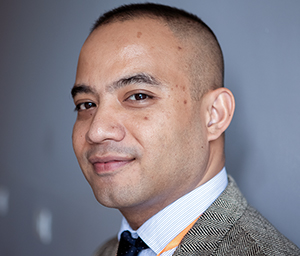Ashish Bajarcharya
Question: How can we change social norms to prevent violence against women and girls (VAWG)?
“As we have spoken about today in the panel, and as we have talked about throughout the meeting, changing norms around violence against women and girls is a very complex and time-consuming process. The most important thing to consider is that we need to help build resources for girls, help provide them the right type of enabling environment and enable various supportive factors: that’s how you can facilitate the process that drives long-term social norm change. We shouldn’t be impatient with how long it takes to change social norms. It may take a long time but it is not impossible.”
“We have talked the distinctions between attitudes and behaviours and the fact that sometimes attitudes turning into behaviour takes a long time, but that is the essential change that needs to happen for norm change. Behaviour change is the norm and that is what we need to focus on. So enabling supportive factors, and providing resources to girls, helps drive behaviour change; and that’s how we change norms. But we need to think beyond girls. We also need to involve families and communities to drive norm change. We need to involve people who are of influence in families, like fathers and community leaders, who can shape the opinions and ultimately the behaviors of communities.”
Question: Could you share with us a success story on social norm change that has contributed to end VAWG?
“I would say, women’s economic empowerment – particularly through their participation in self-help groups or microcredit groups – can have significant implications for reducing violence. Participation in groups typically has long-term implications for reducing violence, although there might be an escalation of violence in the short-term, as men face challenges to gendered social norms. But as women begin to gain acceptance as economic beings and with other support in society, this will translate in positive norms and reductions in violence against women. This is one thing that we have seen in different settings.”
“I think engaging men and boys is also another factor that is really important. Usually, men and boys are seen as perpetrators of violence, but many programmes that involve men and boys as partners, facilitators, and supporters are the type of programmes that advance gender equitable attitudes and norms against violence. If men and boys are engaged from a very early age, then they adopt gender egalitarian attitudes and behaviours and become less likely to perpetrate violence. So I think, those are two things that hold promise and are things we can look at in terms of success stories.”
Question: What would you suggest to policy-makers to advance ending VAWG?
“To invest in evidence-based programmes. Before investing in any kind of programme, one should look at the strength of the evidence of its effectiveness, to see if the programme actually is causing the reduction of violence and it is not just a spurious or false connection. We have talked about the need for rigorous research, and it can be triangulated research that involves mixed methodologies, including quantitative and qualitative methods. One can do a range of research activities, but the design of programmes must be based on sound research and evidence that it works.”
“I think, policymakers should also think about cost-effective and sustainable programmes, which communities themselves can take on and implement in the future. Once donor-funding ends, programmes need to have in-built systems where the natural next step is for communities to own and implement programmes through sustainable means of funding. In addition to investing in these types of programme, donors also must be patient in how soon they expect results. Social norm change takes time and shorter programmes may not show immediate effects. Donors should invest in programmes that have longer time horizons so that these impacts may be realised.”
Question: Could you give me a call for action?
“More rigorous, longitudinal research around women and girls and violence that focuses on how norm changes around gender equity and violence can be set in motion and to translate these changes into better results for them and their families further down the road is essential”
About the expert
Ashish Bajarcharya
Position: Country representative of the Population Council in Cambodia and an associate in its Reproductive Health Programme .
